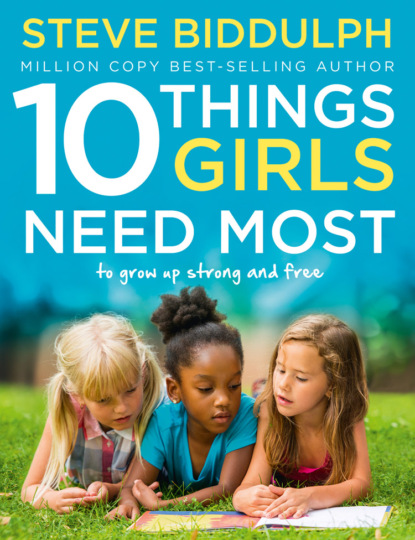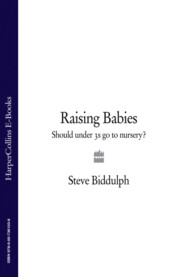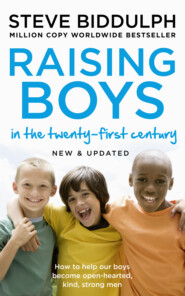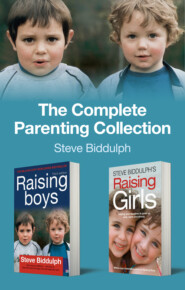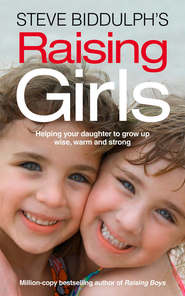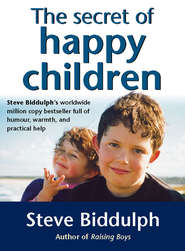По всем вопросам обращайтесь на: info@litportal.ru
(©) 2003-2024.
✖
10 Things Girls Need Most: To grow up strong and free
Автор
Год написания книги
2018
Настройки чтения
Размер шрифта
Высота строк
Поля
Let’s make a baseline assessment of how exploratory, adventure-loving and confident your daughter is. You’ll notice we’ve combined two kinds of adventurousness – outwards, physically, in the world, and inwards in creativity and mental freedom. Of course, having both is brilliant.
Tick which of these best describes your girl:
□ 1. She is very anxious, neat and buttoned up. She is happiest playing with an iPad as it doesn’t mess up her clothes.
□ 2. She sometimes does creative or adventurous things. But not a lot.
□ 3. She loves to play, outdoors or inside: she gets noisy, makes a bit of a mess and loves having adventures.
□ 4. We haven’t seen her for three days, but she sends a smoke signal from a ridge at sunset, so we know she’s OK.
Now, role modelling has to come into this. So we have to ask a second question:
How about you when you were a child?
□ 1. I was very anxious, neat and buttoned up. I did embroidery, but only between the lines.
□ 2. I did occasionally do something creative or adventurous. But it got me into trouble.
□ 3. I loved to play, get noisy and make a bit of a mess, and had many adventures.
□ 4. I hitchhiked across the country at seven, and wrote a book about it called Truck Drivers Are My Friends.
(Please note, this is not to say that every girl, or boy, should be loud and highly active. Some kids are naturally quieter and more into fine motor activity which is just great. The question is: do they feel free. Are their spirits soaring, or afraid?)
The years from two to five are very formative. So we have to really decide what we want to teach them. Sexism really sets in, often without us realizing it. It happens because we shepherd girls – much more than boys – into a restricted and narrow world. We teach them to be neat, clean, quiet, well-behaved and high-achieving (in ballet or music or schoolwork). We create uptight, cute little conformity machines, and wonder why they often implode into anxiety, self-harm and binge-drinking by mid-secondary school.
In the UK, schools don’t help this because politicians (not educators) have imposed testing and assessments and all kinds of irrelevant pressures on even the youngest kids in reception class, or kindergarten. And it’s easy for children to get that feeling at home too – that you have to be the best. Which is crazy. Life is not a competition. And even if it was, children grow smarter, stronger, and have better sensory systems and a greater love of learning if they are allowed to play free until the age of seven. At least.
THE CURSE OF PERFECT
Writers such as Oliver James in the UK and JoAnn Deak in the US (see recommended books) have expressed serious concern about girls’ growing perfectionism about their own performance – about being, essentially, too good. It begins in primary school, with schoolwork, appearance, behaviour and sporting achievement; as they enter their teens it can result in girls controlling the shape of their bodies through diet and exercise to unhealthy levels. It can end in total mental collapse.
New research has revealed something very startling – that the most anxious girls today are often those with educated and affluent parents. A concern that our girls perform well academically is turning into something that actually undermines their success, and makes them very unhappy young women.
We’ve long known that boys are often disadvantaged in early schooling because they don’t like having to sit still, and are slower at achieving reading and writing skills because their brains develop more slowly. But it’s likely that girls suffer an equally harmful consequence of formal learning too young. Because they are ‘good’ at school, girls may get lots of reinforcement – not for being themselves, or doing or making what they want – but for pleasing and conforming to what the teacher, or mum or dad, thinks is good. They develop what psychologists call an ‘external locus of control’ and think that their happiness depends on the approval of others. That’s why it is so vital that we keep the under-six years free from formal learning, and allow children’s natural capacity for self-directed play to develop, leading to strongly motivated, active and creative learners.
Your daughter needs, at this age, to feel FREE. That the world is hers to explore, that it is a rich and beautiful place and she can gain the competencies to navigate it safely. ‘Free’ doesn’t mean free to be selfish or mistreat others, or to be heedless and stupid (or wander in the traffic). You’ll sometimes have to sort her out on that. But it does mean trusting that intelligence grows, people skills develop, strength and confidence, even wisdom and inner peace, arise from being in direct contact with the living world through play. On the outside, and inside, in her own mind – you need to get your daughter exploding into an exploratory life. As feminism puts it, a girl’s place is EVERYWHERE.
HOW NATURE BOOSTS HER INTELLIGENCE
A couple of years ago a strange thing happened. Two books came out with the same title, Wild.
One was a true story, which became a wonderful film, about a young American woman who had been very self-destructive, addicted to men and to drugs and full of insecurity. When the wonderfully named Cheryl Strayed’s mother suddenly died, it triggered her descent into a free-falling lifestyle that seemed set to kill her. She finally decided to heal herself, not through therapy, but by walking thousands of miles along the Pacific Crest Trail. And it worked.
The other book was by a British woman, also a superb writer. Jay Griffith described how important it is to spend time in wild nature, let it fill your mind, and get away from the artificial and deadening environments of cities, buildings, electronics, deadlines and rush. Griffiths lived among indigenous people all over the world to research the book. She followed this book with another, called Kith, which argued that children need a home territory, a landscape, a place with both natural and human dimensions, which they are free to roam in during childhood. That having a home territory you are bonded to is the basis of wellbeing. In a world where we often move from city to city, and live in apartments far above city streets, this is quite a challenging idea.
It’s hard to do justice to these books in a few words, but they won worldwide acclaim, in their own way, for depicting how womanhood could break out of its chains, and how girlhood should never be chained in the first place.
One of the most important things to know about your daughter is that she is a wild creature, and needs to stay that way to be healthy and reach anything like her full potential. By the age of one or two, she will be well ready to venture out into the world of nature, put bits of it into her mouth, climb, poke, chase small lizards, collect feathers and build twig houses, and get in touch with her inner elf. (That’s not a misprint!) These are not just diversions or pleasant interludes from the real business of childhood – they are what childhood is for. Our eyes, ears, hands, limbs, feet and, ultimately, our brain need the complex and richly sensory world that only nature can provide. Rough ground makes our feet and limbs grow stronger, our brains more agile.
Please understand: the message isn’t just ‘it’s healthy to get outdoors’. It’s that in the complexity and richness of the natural environment, a child’s senses begin to work at a significantly more refined and detailed level. (Just one example – 20:20 vision is simply the normal level – it’s possible to have 20:10 vision. And there are comparable increases possible in smelling, hearing, touch, and sensorimotor awareness). When this begins to occur, then your daughter’s brain also perceives more holistically, and sees the relatedness of the environment. A surprising number of the world’s best thinkers and researchers were immersed in nature to an unusual degree, and their brains are different and better as a result.
BUSTING THE STEREOTYPES
The ideal of the neat, tidy, pretty, domesticated girl of times gone by still seems to be hanging on in our idea of girlhood. And in fact it’s being made worse by the new fashion-and-frills dressing habits of our crazy consumerist time. If your clothes are cutesy pink and fluffy and cost a bomb, then you aren’t going to be playing in the mud.
Personally I think the words ‘kids’ and ‘fashion’ should never be seen together. Kids should dress for warmth, mobility and the kind of individuality that they can create themselves without ever going near a shop. Dressing our kids up to be cute can be fun for adults, and a little won’t kill you, but it’s the razor’s edge of turning a girl (or boy) towards self-consciousness and focusing on how they look, which in this era of massive anxiety about looks will be total poison to their mental health.
And then there are toys. We got rid of the little ovens, washing machines and toy irons that girls had in the 1950s, but substituted false eyelashes, pouty fishnet stocking dolls, pink pretty princess outfits (‘some day my prince will come’) and cut-to-the-crotch dancewear. Not exactly progress.
My sister actually had one of these, a toy iron! You could put a battery in it and it lit up the ‘on’ light. That’s all it did! So she could have fun practising ironing. Just like mother!
It isn’t a bad thing for kids – of both genders – to play at being grown up. Making food, building houses, playing at being families. But when toys are made that way – and there is a girls’ aisle and a boys’ aisle in the toy store – then we have a problem.
The real solution to sexist rubbish foisted on girls (along with not buying it) is to make her so strong and free, so early, that she just laughs at this stuff at eight, or fourteen. So the answer is – girls need wilding! You learn this through making messy artwork and building stuff in the backyard, gardening, and making things from mud and leaves. And mum and dad joining in. Through dancing and leaping about in the living room to loud music with mum and dad and friends. In having and keeping animals, fish and tadpoles, and growing every kind of plant. And whenever possible, being in the rain, woods, and on the beach. Encourage her to be messy, uninhibited, alive and moving about. Never complain about the state she gets in. Choose her clothes to be dirt-proof and damage-resistant, water-excluding or so sturdy it doesn’t matter. And whenever you can, get outdoors into natural places and let her run free.
So here is a quick assessment on the natural wildness opportunities your daughter has (tick any that fit):
□ 1. My daughter is frightened of soil. She rarely ventures outdoors.
□ 2. We live in an apartment or flat where there is very little nature around.
□ 3. We have a garden or a park nearby, and do go there sometimes.
□ 4. We get out into nature whenever we can, have a pet, and do a lot of playing outdoors.
□ 5. We live in the countryside, and she plays in wild woods and I have to get twigs out of her hair.
And on inner wildness:
□ 1. Our family is neat. We are quiet. Our goal is achievement. That takes discipline and there is no room for messing about.
□ 2. We do occasionally let our hair down and it’s actually quite good fun.
□ 3. Our daughter/s are very happy making a creative mess with paints and paper and glue and bits of stuff. They get it all over themselves, but it’s nothing a warm bath won’t fix.
□ 4. Our kid’s favourite activity is wild dancing to loud music in the kitchen and living room. Everyone goes mad. When we go to mountain tops we end up shouting our names very loud.
If you ticked 1 or 2 on these two lists, don’t panic!
That’s what this chapter is to help you with. Please note – wildness should not be confused with being chaotic, disorganized or lacking routines. Kids and families do work best with boundaries and structure. You can only be truly wild when you know not to cut yourself, and there isn’t cat poo on the bathroom floor – at least, not from last week. And especially if you don’t own a cat!
EVERYONE CAN DO IT
Not everyone can live beside the woods, or the beach, or in a village where you can walk safely about with friends when you are seven. Where you can light a fire and make toast, or create your own shelter and wait with your dad to watch a badger emerge from its den at dusk. But can you see how wonderful and enlivening and freeing such a childhood could be? And begin to bring even some of that into your daughter’s world? Even in the city, adventure is there. And nature can be found somehow, even just on holidays. So have that kind of holiday or weekend whenever you can. Many women remember being a child, totally blissed out on their first time on a lonely beach, or a hilltop they walked up with mum or dad, where they could see for miles around, and the wind blew in their hair.
“Our daughter would play with sticks, pebbles, pieces of leaf and strange insects for hours in our garden. (And we lived in a place where there were snakes, large lizards called goannas up to a metre long, swooping kookaburras and sometimes hawks or eagles.) Her attention span was so great that it wasn’t even a ‘span’ at all, it flowed all day long. She would make up stories, voice the dialogue between the characters, breaking off only occasionally to bring something to show us or to get something to eat or drink.”





